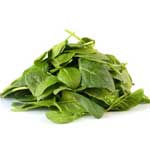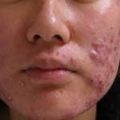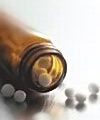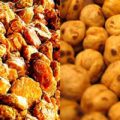Iron is essential to all body cells. Iron functions primarily as a carrier of oxygen in the body, both as a part of hemoglobin in the blood and of myoglobin in the muscles. Iron deficiency anemia occurs when there is not enough iron in the red blood cells. This is a common problem often caused by pregnancy, blood loss, and a diet low in iron or poor absorption of iron by the body.
There are a variety of possible symptoms of iron deficiency including:
- lack of energy or tiredness
- extreme fatigue and feeling of weakness
- light headedness
- headache
- pale skin on the lining of the eyes, the inner mouth and the nails
- rapid and forceful heartbeat
- low blood pressure with position change from sitting to standing up
- finger nails that become thin, brittle and white – they may grow abnormally and get a spoon-shaped appearance
- tongue may become sore, smooth and reddened
- decrease in appetite
- shortness of breath during exercise
- brittle hair
- reduction in immunity and increased vulnerability to infection
- a strong desire to eat nonfoods such as ice, paint or dirt (a condition called Pica)
- disturbed sleep
- abdominal pain
Because the typical symptoms of iron deficiency have many causes, diagnosis by a blood test is needed to confirm the presence of iron deficiency anemia.
The Recommended Dietary Allowance (RDA) for iron for non-vegetarian pre-menopausal women is 18 mg/day. The RDA for non-vegetarian men and post-menopausal women is 8 mg/day. Because of iron absorption issues in a healthful, high-fiber vegetarian diet, the RDAs for vegetarians are higher – 14 mg/day for vegetarian men and 33 mg/day for vegetarian women. Iron absorption should be twice for vegans who exclude all animal products. The upper level of intake should not exceed 45mg/day.
The Food and Nutrition Board at the Institute of Medicine recommends the following:
Infants and children
- Younger than 6 months: 0.27 milligrams per day (mg/day)
- 7 months to 1 year: 11 mg/day
- 1 to 3 years: 7 mg/day
- 4 to 8 years: 10 mg/day
Males
- 9 to 13 years: 8 mg/day
- 14 to 18 years: 11 mg/day
- Age 19 and older: 8 mg/day
Females
- 9 to 13 years: 8 mg/day
- 14 to 18 years: 15 mg/day
- 19 to 50 years: 18 mg/day
- 51 and older: 8 mg/day
Women who are pregnant or producing breast milk may need different amounts of iron. Ask your health care provider what is appropriate for you.
What can I do to prevent iron deficiency?
In general, you can eat a healthful diet that includes good sources of iron. A healthful diet includes fruits, vegetables, whole grains, fat free or nonfat milk and milk products, lean meats, fish, dry beans, eggs, nuts, and is low in saturated fat, trans fats, cholesterol, salt, and added sugars.
In addition to a healthful diet that includes good sources of iron, you can also eat foods that help your body absorb iron better. For example, you can eat a fruit or vegetable that is a good source of vitamin C (see table on Dietary Sources of vitamin C) with a food or meal that contains non-heme iron (see table below for Dietary Sources of Iron). Vitamin C helps your body absorb the non-heme iron foods you eat, especially when the food containing non-heme iron and the vitamin-C rich food are eaten at the same meal.
The following recommendations are for specific groups who are at greater risk for iron deficiency.
Babies
- If possible, breastfeed your baby for at least 12 months and starting at 4 to 6 months of age, give your baby plain, iron-fortified infant cereal and/or pureed meat. Just two or more servings a day can meet a baby’s iron needs at this age. Meats should be home prepared or commercially prepared plain pureed (chopped until smooth in a blender) meats.
- When your baby is about 6 months of age, include a feeding per day of foods rich in vitamin C with foods that are rich in non-heme iron to improve iron absorption.
- If you can’t breastfeed, use iron-fortified formula.
- Don’t give low-iron milks (e.g. cow’s milk, goat’s milk, and soy milk) until your baby is at least 12 months old.
- If your baby was born early or small, talk to your doctor about giving iron drops to your baby.
- If your baby can’t get two or more servings per day of iron rich foods (such as iron-fortified cereal or pureed meats), talk to your doctor about giving iron drops to your baby.
Young children (aged 1–5 years)
- After your child is one year old, give no more than three 8 ounce servings of whole cow, goat, or soy milk per day. After your child is 2 years old, low fat or nonfat milks should be used in place of whole milks. Vitamin D-fortified milk is a good source of calcium and vitamin D, but not iron.
- Give your child a diet with iron-rich foods such as iron-fortified breads and iron-fortified cereals and lean meats.
- Include fruits, vegetables or juices that are rich in vitamin C. Vitamin C helps your child absorb non-heme iron especially when the food that is a source of non-heme iron and the vitamin C-rich food are eaten at the same meal.
Adolescent girls and women of childbearing age
- Eat iron-rich foods.
- Eat foods that are vitamin C sources. Vitamin C helps your body absorb non-heme iron especially when the food that is a source of non-heme iron and the vitamin C-rich food are eaten at the same meal.
- Eat lean red meats, poultry, and fish. The iron in these foods is easier for your body to absorb than the iron in plant foods.
Pregnant women
- Eat iron-rich foods.
- Eat foods that are vitamin C sources. Vitamin C helps your body absorb non-heme iron especially when the food that is a source of non-heme iron and the vitamin-C rich food are eaten at the same meal.
- Eat lean red meats, poultry, and fish. The iron in these foods is easier for your body to absorb than the iron in plant foods.
- Talk to your doctor about taking an iron supplement.
Dietary Sources of Iron – Iron in diet
HEME Iron | Serving | Iron (mg) |
| *Beef, chuck, lean | 3.0 | 3.2 |
| Beef, corned | 3.5 | 1.9 |
| Beef, eye of round, roasted | 3.0 | 2.2 |
| *Beef, flank | 3.5 | 3.3 |
| Beef, lean ground; 10% fat | 3.0 | 3.9 |
| Beef, liver | 3.0 | 7.5 |
| *Beef, round | 3.5 | 3.1 |
| Beef, tenderloin, roasted | 3.0 | 3.0 |
| Chicken, breast, roasted, | 3.0 | 1.1 |
| Chicken, leg, meat only, roasted | 3.5 | 1.3 |
| Chicken, liver | 3.5 | 12.8 |
| Chicken, thigh w/ bone | 2.3 | 1.2 |
| Clams, breaded, fried, | ¾ cup | 3.0 |
| Cod, broiled | 3.0 | 0.4 |
| Flounder, baked | 3.0 | 0.3 |
| Oysters, breaded and fried | 6 pieces | 4.5 |
| *Pork, lean ham | 3.5 | 1.5 |
| *Pork, loin chop | 3.0 | 1.2 |
| Salmon, pink canned | 3.0 | 0.7 |
| Shrimp, mixed species, cooked | 4 large | 0.7 |
| Tuna, canned in water | 3.0 | 0.8 |
| Turkey, dark meat | 3.5 | 2.3 |
| Turkey, white meat | 3.5 | 1.6 |
| *Lean, trimmed of separable fat | ||
NON-HEME Iron | Serving Size | Iron (mg) |
| Almonds, raw, whole | 10-12 | 0.7 |
| Apricots, dried, med.-size | 10 | 1.7 |
| Bagel | 1 whole | 1.5 |
| Baked beans, canned | ½ cup | 2.0 |
| Black beans, boiled | 1 cup | 3.6 |
| Black-eyed peas (cowpeas), boiled | 1 cup | 1.8 |
| Bread, white, enriched | 2 slices | 1.8 |
| Bread, whole wheat | 2 slices | 1.8 |
| Broccoli, cooked | ½ cup | 0.6 |
| Broccoli, raw | 1 stalk | 1.1 |
| Dates | 10 each | 1.6 |
| Grits, quick enriched white, cooked | 1 cup | 1.5 |
| Kidney beans, boiled | 1 cup | 5.2 |
| Lentils, boiled | 1 cup | 6.6 |
| Lima beans, boiled | 1 cup | 4.5 |
| Macaroni, enriched, cooked | 1 cup | 1.9 |
| Molasses, blackstrap | 1 tbsp. | 3.5 |
| Navy beans, boiled | 1 cup | 4.5 |
| Oatmeal, fortified instant, prepared | 1 cup | 10.0 |
| Peas, frozen and prepared | ½ cup | 1.3 |
| Pinto beans, boiled | 1 cup | 3.6 |
| Prune juice | ½ cup | 1.5 |
| Raisins, seedless packed | ½ cup | 1.5 |
| Rice, brown, cooked | 1 cup | 1.0 |
| Rice, white enriched, cooked | 1 cup | 1.8 |
| Soybeans, boiled | 1 cup | 8.8 |
| Spaghetti, enriched, cooked | 1 cup | 1.6 |
| Spinach, cooked (boiled, drained) | ½ cup | 3.2 |
| Spinach, canned, drained | ½ cup | 2.5 |
| Spinach, frozen, boiled, drained | ½ cup | 1.9 |
| Tofu, raw, firm | ½ cup | 3.4 |
| Vitamin supplements | varies | varies |
In addition, many breakfast cereals are iron-fortified. Check nutrition information on package label for specific iron content.
Enjoy your best health with iron-rich diet 🙂











3 richest veg. source of Iron
– Oatmeal
– boiled Soybeans
– boiled Lentils